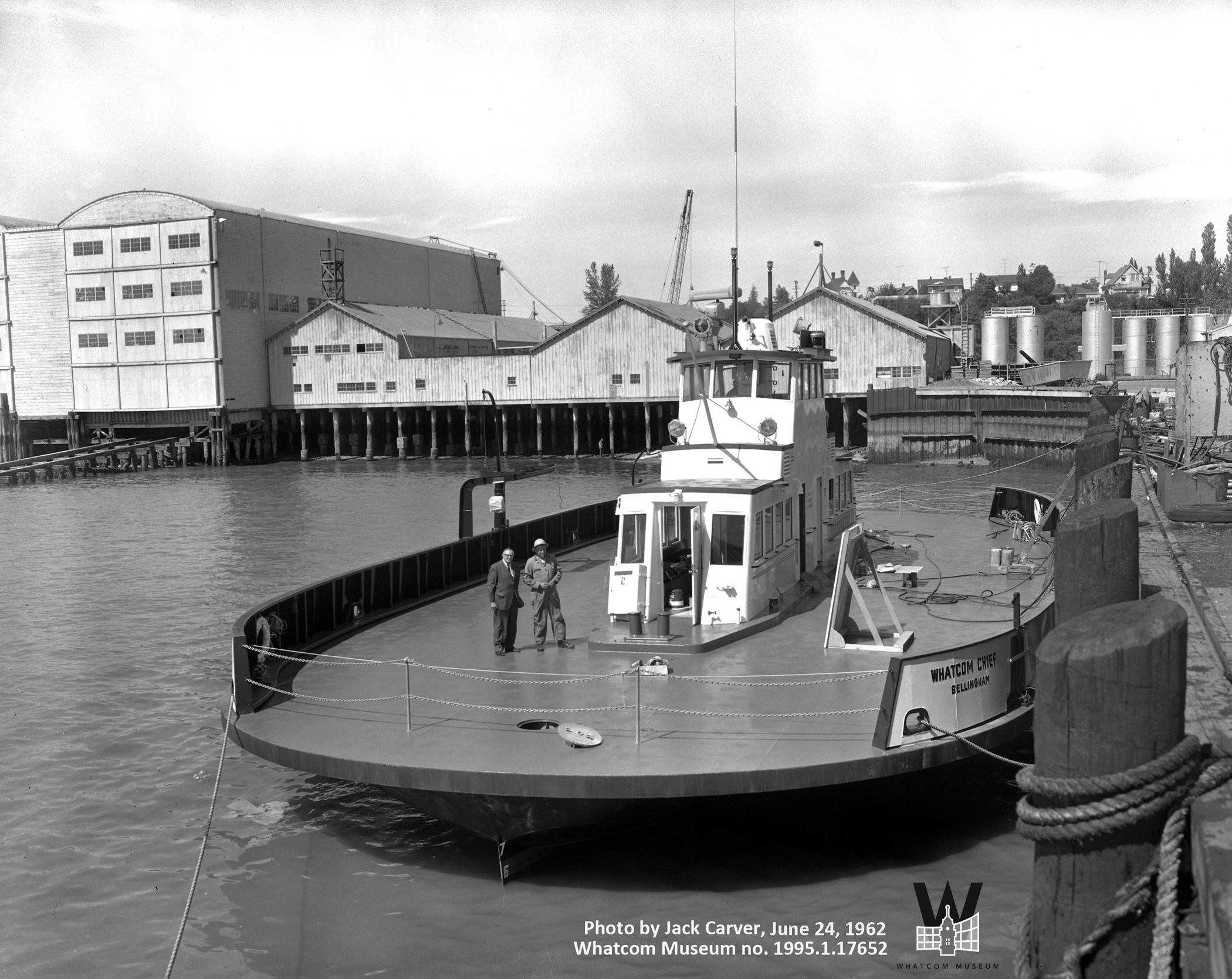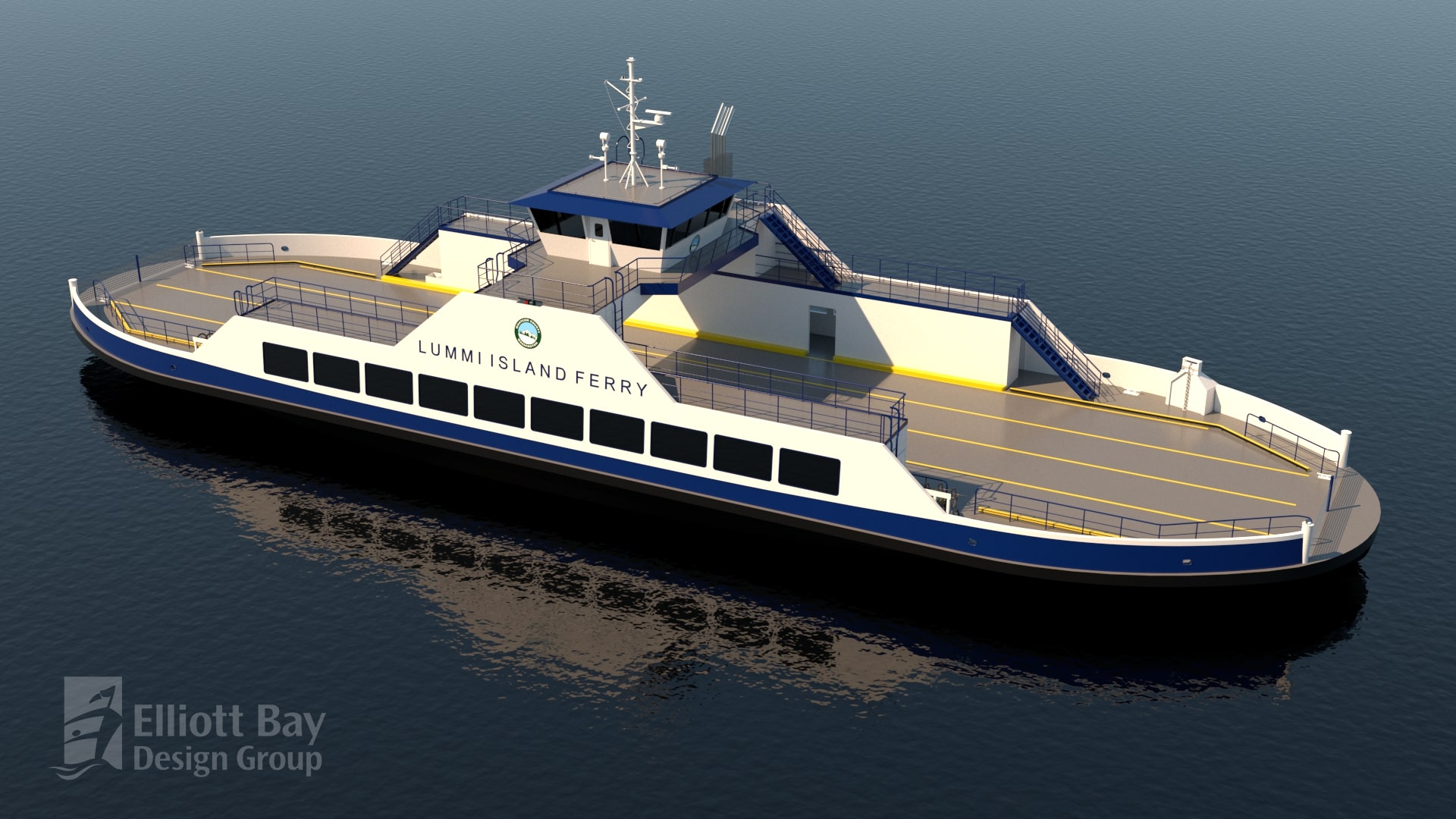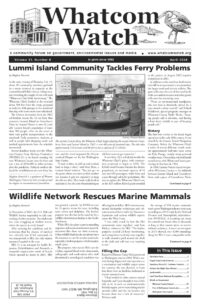by Meghan Fenwick
In the early evening of Thursday, Feb. 15, about 20 community members gathered in a room strained to capacity at the Lummi Island Public Library. A large banner stretching the length of one wall read “Whatcom Chief 60th Anniversary.” The Whatcom Chief, docked at the terminal about 500 feet from the room, prepared to make its 30th passage to the mainland that day, with seven more runs scheduled.

Courtesy: Whatcom Museum
The current Lummi ferry, the Whatcom Chief, began plowing the waters between Gooseberry Point and Lummi Island in 1962 — over 60 years of sustained trips. The ride takes approximately 5-6 minutes and the ferry has a capacity of 12 vehicles.
The leftover decoration from the 2022 celebration means the 12-car ferry that connects Lummi Island to Gooseberry Point in Lummi Nation is now 62 years old. Lummi Island’s population of more than 900 people relies on the vessel as their only public transportation to the mainland. Daily commuters, students, as well as people with shopping needs and medical appointments have the schedule memorized.
Several deadlines loom over the Whatcom County Ferry Advisory Committee (WCFAC) (1) at its fourth meeting this year. Whatcom County runs the ferry and saw a loss of $358,000 in ticket revenue after the pandemic. Political conflicts delayed the establishment of a new ferry fare rate, and the vessel surpassed the 60-year standard lifespan set by the Washington State Ferries.
“I used to drive an old car and worked hard to keep it alive,” said Mary Ross, a Lummi Island resident. “You just get to the point where you have to find another one because it gets too expensive to keep the old one alive. They work really hard to maintain it, but the cost of maintaining an old boat starts to get expensive.”
A new ferry (2) is scheduled to take the Whatcom Chief’s place, with construction projected to begin in 2026. The hybrid vessel features batteries for electric propulsion, an increased capacity of 34 cars and 150 passengers, wider lanes and a pass-through cabin for pedestrians. The race to replace the Whatcom Chief is on, as the $25 million federal grant awarded to the project in August 2022 requires completion in 2031.
In addition to the new boat, both terminals will be reconstructed to accommodate the larger vessel and electric utilities. The grant will cover the cost of the vessel itself, while user and tax revenue and other grants will cover the remaining costs.
“From an environmental standpoint, this new boat is absolutely critical for a step towards carbon neutral,” said Roland Middleton, special programs manager at Whatcom County Public Works. “Keeping people safe is absolute, and having a boat that’s reliable is part of keeping people safe.”
History
The first ferry service to the island began operations in the early 20th century. It was owned by the Lummi Island Navigation Company. Before the Whatcom Chief, a series of several different vessels made the approximately half-mile route across the Hale Passage, usually steam-powered wooden boats. Ownership switched hands several times, with Whatcom County purchasing its first boat in 1924.
In 1988, Lummi Nation leased two parcels to Whatcom County — the tidelands between Lummi Island and Gooseberry Point and a piece of Gooseberry Point. Lummi Island sits in the ancestral homeland of Lummi Nation and is currently unincorporated land of Whatcom County. The county pays Lummi Nation monthly for the ferry service, an agreement that did not come without controversy when the contract was extended in 2011.
The contract was set to expire in 2010. Lummi Nation discovered that the Bureau of Indian Affairs (BIA) had not signed on in 1988, making the contract invalid. The tribe eventually settled on a $200,000 annual rental payment which would scale with inflation over time for the tidelands lease. For the uplands lease, the contract requires the county pay Lummi Nation $6 million in three installments to improve road conditions.
Mary Ross first moved to the island in 2003 and remembers when a round-trip ticket cost only $4 for a vehicle and one dollar for a pedestrian or passenger. Today a round-trip ticket costs $14 for a driver and vehicle and $8 for a pedestrian. She also recalls being caught in the middle of these negotiations.
“There was a feeling that the county wasn’t really willing to listen to us about the fate of the people that lived on the island during the lease negotiations,” Ross said. “The Lummi Island Community Association (LICA) (3) got involved by at least paying for a space for the community to meet and talk as a group as we tried to come to grips with the possibility of losing ferry service to Gooseberry Point. It was pretty scary for us.”
LICA is a nonprofit organization that provides a forum for islanders to communicate all things Lummi Island. LICA also sponsors other local events such as blood drives and the Meals on Wheels program. Ross served as president of the board of directors from 2015 to 2018, and again from 2021 to 2023.
In August 2023, LICA held another town hall when community members took notice of the ferry finances yet again. Whatcom County’s Public Works Administration proposed to increase the fare by 35 percent, raising several questions (4) from islanders.
Rocking the Boat
Public Works first suggested a fare increase on Dec. 6, 2022. Lummi Island has not seen a change in fares since 2015, and Public Works reported a revenue deficit of $1 million.
The fare revenue currently covers 55 percent of the costs to run the ferry, while the county pays 45 percent through county funds or grants. All other costs, deemed “capital costs’’ are paid for by the county. If the revenue does not match 55 percent of the regular costs, a fare increase might be necessary to recover the deficit.
“Prices have gone up for everything except the fares to get to Lummi Island,” Middleton said. “Diesel is five times what it was, wages for the crew, repairs. Just the cost of taking the boat to dry dock is now more than what it used to be.”
Public Works withdrew its proposal for a 35 percent fare increase on April 25. A citizen’s group called the Lummi Island Work Group provided documentation showing that the farebox revenue was not actually in a deficit. Previous analyses had underestimated contributions from the state, including the Motor Vehicle Fuel Tax, which contributes to total expenses of the ferry.
The farebox revenue held a surplus of about $1 million based on new calculations. Public Works Financial Services Manager Randy Rydell broke this down at a meeting in May to the Lummi Island Ferry Advisory Committee (LIFAC), WCFAC’s predecessor.
Alongside the proposal to increase fares was a proposal to update WCC #10.34 (5), the code which governs the ferry financing system. Public Works’ version redefined the terms “regular and routine maintenance” to mean “operating expenses” — raising eyebrows from Lummi Island residents. Among their concerns was that the new language would allow big ticket items to be tacked on to their share of the expenses.
One item included in the “regular and routine maintenance” bill was a set of dolphins, or pillars that guide the Whatcom Chief into the terminal on the Lummi Island side. Completed in November 2022, the repair cost $800,000, 55 percent of which was charged to the farebox fund. This is a point of contention between parties, islanders believing that this was misappropriated and should be considered a capital expense.
“Regular and routine maintenance is the work you do to keep your boat going and your docks working,” said Bob Anderson, former moderator of the Lummi Island Work Group. “Something that is regular and routine is something that’s predictable. It’s budgeted.”
LIFAC received backlash from the community in the summer of 2023, leading to several committee members’ resignations. By the time the county council voted in favor of Public Works’ code amendments, only three out of seven members remained. LIFAC was therefore unable to form a quorum and advise the county on such changes.
While LIFAC sat dormant, the Lummi Island Work Group continued to analyze the accounting structure of the ferry and collect community input. The group circulated a petition, signed by more than half of the island’s residents, for Public Works to withdraw its proposed changes to the ordinance.
All Hands on Deck
On July 25, 2023, the county council passed the ordinance to adjust the code with a 5-2 vote. Two weeks later, County Executive Satpal Sidhu vetoed the decision, the first of his time in office.
“Trust is always about people,” Anderson said. “You don’t trust things. You trust the people that are associated with those things or those organizations. I believe that the action by the executive was a courageous one.”
In a memo explaining his Aug. 9 veto, Sidhu said that council members had given the community the impression that final decisions would be paused until an advisory committee could convene and provide comments.
“I hope that the council, as our policy and legislative body, will work with LIFAC to ensure that county code related to ferry rates reflects the interest of our constituents, both on the island and across the county,” the memo reads.
The county council did not use its power to overturn the decision. Instead, councilmember Kaylee Galloway proposed a timeline for action, including filling vacant positions by November, amending the rules of the ferry advisory committee and increasing the membership from 7 to 10, and scheduling due dates for all parties to suggest their own code and fare changes. LIFAC became WCFAC as a result.
Among WCFAC’s concerns is the still pressing issue of which costs are paid in part by the fare revenue. Recently, Public Works suggested changing “regular and routine maintenance” to “non-capital,” where fare revenue would pay for 55 percent of noncapital expenses. Another priority is what happens when there is a fare surplus, where WCFAC proposes to only apply the surplus to future fare deficits.
In a meeting on Feb. 20, Sidhu informed the county council of recent news that state revenue for the upcoming fiscal year is projected to be about $500,000 short. He suggested a 15 percent fare increase on March 5. All parties have expressed interest in allocating American Rescue Plan Act funds to the ferry, but Public Works projects a shortfall of $1.2 million in 2026 even with both of these measures enacted soon.
Combined with a projected downward trend in ridership and a downward trend in fare revenue, the possibility of a fare increase is likely in the coming months.
“With the politics of this situation now, we might as well start to discuss bringing back some fare increases,” Anderson said. “But if you go too high and too hard, what happens is a negative spiral.”
At recent meetings, WCFAC discussed changes to the fare structure, such as reducing the burden of a fare increase on pedestrians, changing the structure of multi-ride punch cards during the transfer to a new rate, and introducing a surcharge on summer trips. All parties have expressed a commitment to prioritizing needs-based discounts.
“I think the ferry committee and Public Works would be in agreement that at least we do not raise pedestrian fares, and that the 15 percent increase in revenue comes out of vehicles,” said Diane Harper, vice chair of WCFAC on March 5.
The county is scheduled to take a final vote on the updated code language on April 9, while dates to establish a fare increase are tentative. After these issues are settled, WCFAC will turn its focus to the development of the hybrid ferry and related infrastructure. Public Works, The Executive’s Office, and WCFAC will continue to explore long-term solutions.

courtesy: Whatcom County Public Works
Construction of Lummi Island’s new hybrid ferry, illustrated by this conceptual design, is projected to begin in 2026.
Full Steam Ahead
Middleton began working toward a new ferry for Lummi Island in 2017, when LIFAC and Public Works worked together to create a level-of-service goal. The groups analyzed data points such as daily traffic and peak times, gathered community comments and presented an action plan to the county council.
“Their approach was very academic and mathematical, but no one had ever just sat down with them and asked what they wanted,” Middleton said. “That’s the way I approached it. I don’t live out here, so I’ll write it down and we’ll get going on it.”
One of the biggest priorities for islanders is access to emergency services. There are no hospitals on the island, and the ferry stops running after midnight. For medical emergencies, the ferry will run past its scheduled times. The ferry docks on the island overnight so the ferry can provide emergency service to deliver patients to a waiting ambulance at Gooseberry Point. Another option is an air ambulance; however, helicopters can only land on the island when the weather cooperates.
Years ago, one resident experienced a medical emergency while the Whatcom Chief was under repair for a steering malfunction, and thick fog prevented air travel. They were forced to travel by a private boat. The experience was described to Middleton during the community engagement process, and islanders requested more options. Islanders will have an ADA-compliant passenger ferry to carry them through the construction period.
“There are a lot of smart and engaged people on the island that have really good ideas,” Ross said. “The ferry is something that brings people’s feelings to a head, because it’s something that we all rely on so much.”
Another safety aspect of the new vessel is in the engineering. The hybrid system is necessary in the event of emergencies, especially while the infrastructure to recharge the ferry quickly and overnight at the terminals is still in development. If a situation arises where the ferry needs to unload at the Alaska Marine Highway terminal in Fairhaven, its diesel can provide extra mileage. The goal is to work towards fully electric, the engine room designed with extra space to be retrofitted for new technologies when they become available.
Construction is expected to begin in 2026 during what is known as the fish window, where in-water projects are confined to August through February. The crew must also halt construction when there are sea mammals nearby to avoid inflicting hearing damage.
When the project was initially designed, the projected cost was $50 million. The Department of Transportation awarded $25 million through a federal grant. Other funds include a one-dollar capital surcharge on most fares in 2021, and possible additional grants from the state. In today’s dollars, the estimated cost is several million dollars higher, said Middleton.
The grant requires that environmental reviews are completed by September 2026, and the funds be used by 2031. Public Works estimates completion of the project by 2027.
“A past county engineer used to say that all grants have strings attached, but federal grants have steel cables,” said Middleton. “There’s no messing around because if you no longer meet the criteria, the money can be denied. The county council, the county executive, and everyone involved are very committed to getting this done, because it is so necessary for the people out there.”
Timeline
- 1924: Whatcom County purchases its first ferry service between Lummi Island and the mainland
- 1988: Lummi Nation leases the tidelands across the Hale Passage to Whatcom County
- 2011: Lummi Nation enters the most recent leasing contract with Whatcom County, set to expire in 2036 with a 10-year extension
- 2017: Feb. 21: Whatcom County Council passes Resolution No. 2017-012, establishing a level of service goal for the Lummi Island Ferry
- 2020:
March: Fare collection suspended to maintain social distancing during the pandemic
June: Fare collection resumes - 2022:
Aug. 9: The Department of Transportation awards $25 million toward the new hybrid ferry
November: Dolphin and breakwater repairs completed - 2023:
June 9: Lummi Island Work Group petitions for a pause on the vote to pass Ordinance No. 2023-045, which amended WCC 10.34
June 14: LIFAC holds its last public meeting before multiple vacancies
July 25: Whatcom County Council passes Ordinance No. 2023-045
Aug. 9: County Executive Satpal Sidhu vetoes Ordinance No. 2023-045
Sept. 5: Whatcom County Council proposes a timeline for action to establish a new ferry ordinance and rate structure
Oct. 10: Whatcom County Council amends the Lummi Island Ferry Advisory Committee. This action renamed the committee to the Whatcom County Ferry Advisory Committee, increased the total membership from eight to 10, and established equity components to comply with the Open Public Meetings Act.
Nov. 8: Whatcom County Council appoints seven new members to the Whatcom County Ferry Advisory Committee (WCFAC - 2024:
Jan. 25: WCFAC’s first public meeting
March 14: WCFAC votes on final code recommendations to the Whatcom County Council
March 19: WCFAC presents final code recommendations to the Whatcom County Council
April 9: Whatcom County Council takes action on code changes - 2026: Construction projected to begin for the new Lummi Island Ferry
- 2027: Estimated completion of the new ferry
- 2027: RAISE grant deadline to expend funds
__________________________________________________
Meghan Fenwick is a graduate of Western Washington University who recently earned her degree in environmental journalism.
References:
- https://www.whatcomcounty.us/521/Whatcom-County-Ferry-Advisory-Committee
- https://www.whatcomcounty.us/3432/New-Ferry-Vessel
- https://ourlummiisland.org/
- https://ourlummiisland.org/wp-content/uploads/2023/08/LICA-Tow-Hall-Whiteboard.pdf
- https://www.codepublishing.com/WA/WhatcomCounty/html/WhatcomCounty10/WhatcomCounty1034.html




























